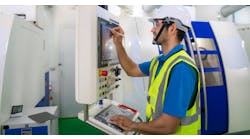As manufacturers adopt Industry 4.0 standards, biometric security measures are being more commonly applied implemented by smaller and mid-size enterprises — machine shops, for example. Such integrated security measures once were considered more appropriate for hospitals, airports, or other fields where access points had to be controlled constantly, but newer research has shown biometrics can be used to improve industrial processes thanks to its use in collecting worker data.
The core concept of Industry 4.0 is data collection, and effective I4.0 infrastructure is built around properly collected data from millions of sensors. In manufacturing operations, this is the justification for manufacturing execution systems (MES). Data is collected constantly and relevant data is used to revise and improve industrial processes on a sustained basis.
Now, new wearable biometric security devices allow workers to integrate into the MES, as yet another measurable layer of the whole working plant. These devices are typically designed as bands or badges that authenticate the wearers at the beginning of each shift, and so workers seamlessly log onto and out of machinery (or, into/out of tool storage cabinets, etc.) without the time, confusion, etc. required for traditional passwords or swipe cards.
This is the technology being integrated into manufacturing now. In fact, Rockwell Automation is gearing up to introduce a wearable device that is synch’ed to an individual’s unique cardiac pattern, specifically designed to work with Rockwell industrial management software.
It is the next logical step in data acquisition as Industry 4.0 matures. Human-to-machine data collection has been an important portion of the CPS (cyber-physical system) of data collection since the advent of information networks.
But, traditional data entry through a tablet can slow production. Devices that can be synced from a biometric pattern and used automatically create a platform that not only tracks when and where workers interact with machinery, seamlessly, but that also maintain data on how long each employee stays focused on each task.
The data gleaned from these sensors allow managers to measure whether a production unit or facility is working at optimal output, and to consider changes such as:
• Adapting workstation locations. If data shows operation is being slowed by improper workflow, the shop floor can be reconfigured for a more efficient flow. Changes also may be considered for the tool storage, material handling, and other auxiliary service areas.
• Reducing bottlenecking in the production line. If data shows a snag in the production line by highlighting a point of slow throughput, actions can be taken to correct the issue. And while serious bottlenecks in a supply chain are typically easy to spot, even shorter backups can significantly impact overall output across an eight-hour shift. If these continue over every shift, the bottom-line loss can be notable.
• Reassigning tasks. Staffing levels may be appropriate across an operation, but incorrect in specific zones. Because biometric bands keep track of how long each employee is on task, it will help to establish any zones that may currently be under- or over-staffed.
Additionally, biometric devices allow managers to “lock out” employees in a similar way as they’ve been doing with equipment for years. But in this case, the equipment is still available for use by individuals who have been properly trained and who have been cleared to use the equipment, while those who have not met training expectations are unable to power up the machinery.
The core concept of Industry 4.0 is data collection, and an effective I4.0 infrastructure requires reliable collection of relevant data from all available sources, including the human sources.
Marla Keene is a staff writer with AX Control Inc., suppliers of industrial automation parts including Reliance Electric, General Electric, Fuji Electric, Horner, Parker, and Eurotherm products. Contact her at [email protected]






